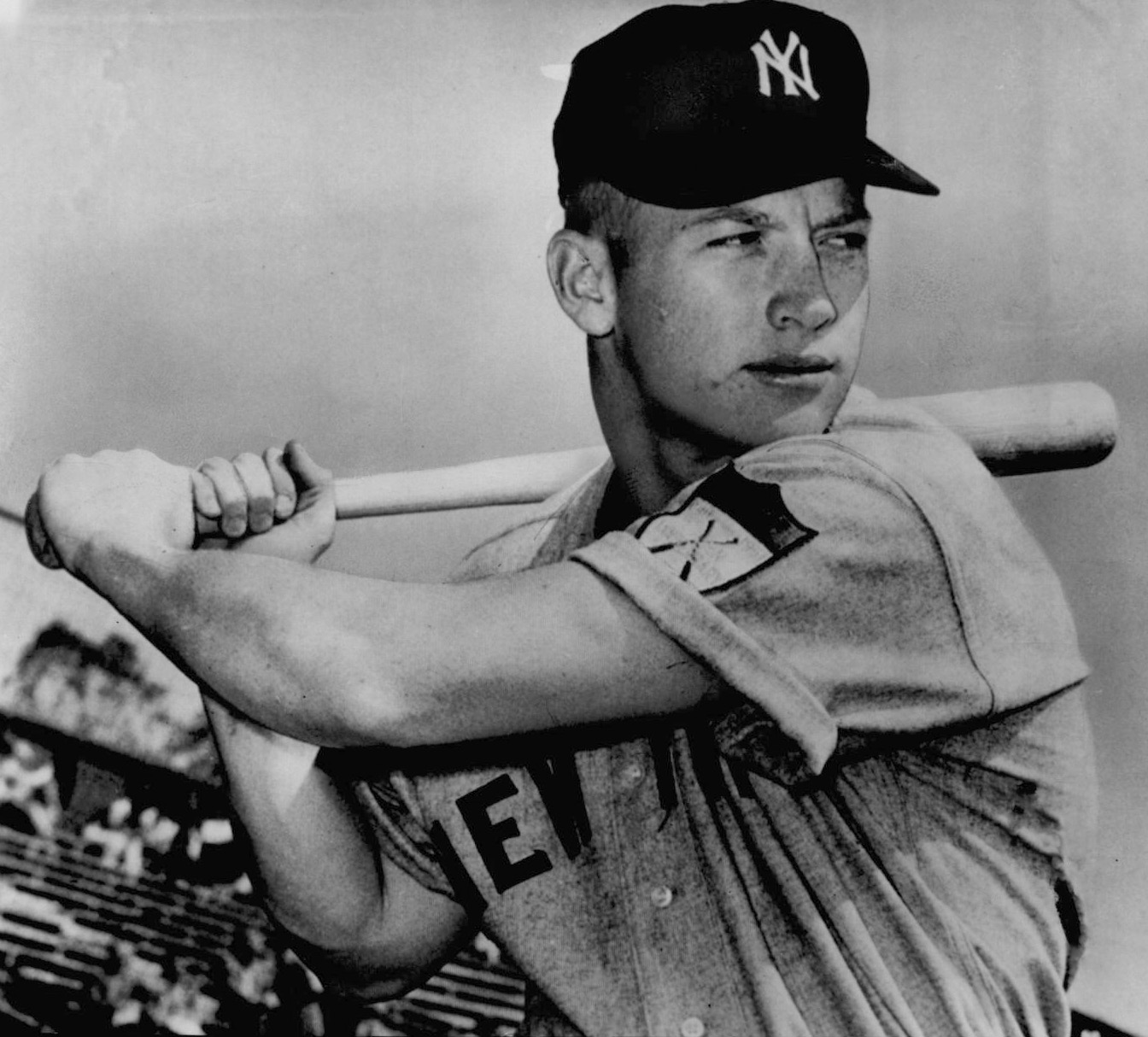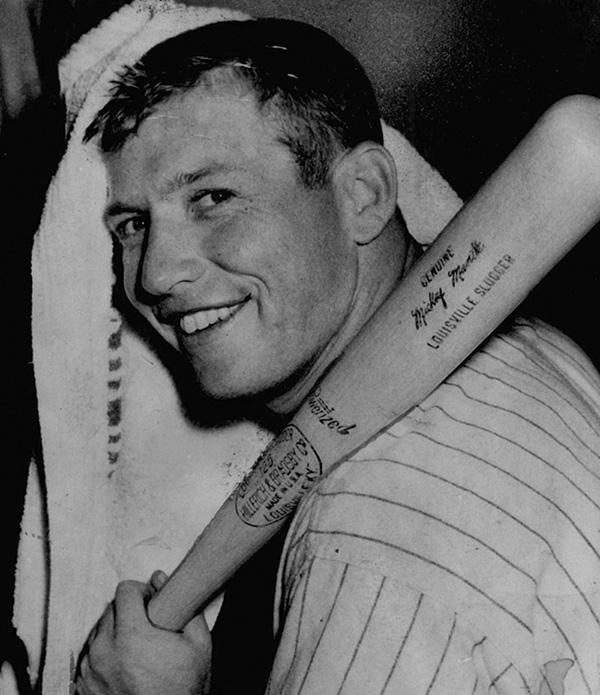
The Encyclopedia of Oklahoma History and Culture
MANTLE, MICKEY CHARLES (1931–1995).
Arguably the most significant Oklahoman in major league baseball, Mickey Mantle slugged 536 home runs with a .298 batting average and 1,509 runs-batted-in during his remarkable eighteen-year career as a switch-hitter with the New York Yankees. He started his career as television grew and thrilled millions of fans with an all-time record of eighteen home runs in twelve World Series. Born October 20, 1931, in Spavinaw, Oklahoma, Mantle grew up in Commerce and was known as the "Commerce Comet" and "The Mick." He was inducted into the National Baseball Hall of Fame in 1974.
He was named after Mickey Cochrane, Hall of Fame Philadephia A's catcher who was the idol of Elvin Mantle, Mickey's father. Elvin Mantle was a fire-balling amateur pitcher who also toiled in the lead and zinc mines of northeastern Oklahoma. Mantle learned to switch-hit by playing with tennis balls thrown by his right-handed father and left-handed grandfather.
On the night he graduated from Commerce High School in 1949, Mantle was playing for the Baxter Springs Whiz Kids in a Ban Johnson League against Coffeyville when legendary scout Tom Greenwade of the Yankees first saw him. Mantle hit two home runs and two singles and made three errors at shortstop. Two days later, in a car after a game was called off for rain, Greenwade offered him a thousand-dollar bonus.
In 1949 Mantle hit .313 for Independence in the K-O-M League and then .383 for Joplin in the Class C Western Association in 1950 with 199 hits, including twenty-six home runs. The Yankees called him up to their February pre-camp school in 1950, but he had no money to make the trip to Phoenix, Arizona. The Yankees found out and wired him the money.
Mantle joined the Yankees as a shortstop during that spring of 1950 when Hall of Famer Joe DiMaggio was still playing center field. Mantle hit .402 in spring training with nine home runs and moved to the outfield. He advanced so fast that Yankee Manager Casey Stengel told Sport magazine that he was confused by the young rookie from Commerce. "I know he's not a big league outfielder yet," Stengel said, "and that he should have a year of Triple-A under his belt. That's the only logical thing. But this kid ain't logical. He's a big league hitter and base-runner right now."
Cliff Mapes, who lived in Pryor, Oklahoma, wore number seven that spring. After Mantle was sent to Kansas City of the American Association, the Yankees traded Mapes to Detroit. Mantle returned late that season and was given his trademark number seven. He replaced DiMaggio as the regular Yankee center fielder in 1951, batting .267 in ninety-six games with thirteen home runs, playing in two World Series games. In 1952 he batted .311 with twenty-three home runs and became a World Series star for the first time. He batted .345 during the Series victory over the Brooklyn Dodgers and hit two home runs.
During his eighteen-year career he was named Most Valuable Player in the American League three times and was named to twenty All-Star teams. He won the American League triple crown in 1956 with a .353 batting average, fifty-two home runs, and 130 RBIs, and he hit a 565-foot home run in Washington's Griffith Stadium, leading to the term "tape measure" home run. Five times he nearly became the first to hit a fair ball out of Yankee Stadium. In addition to eighteen home runs, Mantle holds World Series records of forty RBIs, forty-two runs scored, forty-three walks, twenty-six extra base hits, and 123 total bases. He hit fifty-four home runs in 1961, the year fellow Yankee Roger Maris hit sixty-one home runs to break Babe Ruth's previous record of sixty. Mantle often batted behind Maris that year and that was considered one of the reasons Maris got the pitches he needed to break the record. Mantle hit .333 and three homers in his last World Series in 1964.
Outside of baseball, Mantle, second baseman Billy Martin, and pitcher Whitey Ford became known for their off-the-field and off-season escapades and practical jokes. Mantle told one story of trying to climb into a hotel through a window after the team curfew to avoid being caught by Stengel. They climbed on top of garbage cans, and Mantle helped Martin through the window. Then Martin shut the window and left Mantle outside. Mantle said he tore up a two-hundred-dollar suit in the process.
During the 1960s Martin served as coach and then manager of the Minnesota Twins. Mantle came to Minnesota during a cold January week for the Minnesota baseball dinner. They invited Max Nichols, an Oklahoman who was then writing baseball commentary for the Minneapolis Star, to go with them to hunt ducks on a game farm. It was five degrees below zero with snow on the ground, and the ducks were flying low. Mantle put blanks in Martin's shotgun, and Martin began to blaze away at ducks slightly over his head, without success. Mantle kept a straight face as long as he could but finally rolled over in the snow, laughing.
After his retirement from baseball in 1968, he had a short stint as a Yankee baseball coach, worked as a baseball broadcaster, and worked for a Dallas insurance company and for the Claridge Hotel in Atlantic City, New Jersey. He also was a part owner of Mickey Mantle's Restaurant on Fifty-ninth Street in New York City. He died August 13, 1995, in Dallas, having made his home there since 1956.
See Also
BASEBALL, JOHNNY LEE BENCH, JOSEPH JEROME McGINNITY, WILBER JOE ROGAN, WARREN EDWARD SPAHN, SPORTS, WILVER DORNELL STARGELL, WANER BROTHERS







